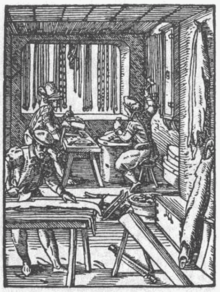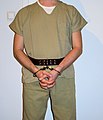belt
A belt (Swiss: 'belt', as a uniform part also (the) 'belt') is a band or braid worn around the middle of the body . It can be used for the cohesion and better fit of clothing, purely for jewelry purposes or to fasten objects. In some cases, belts are used for protection or are only intended to narrow the waist .
history



Some statue menhirs (stone sculptures) from the late Neolithic age depict belts. Several belts made of metal links and chain strings were found in Bronze Age graves. The clasp of Bronze Age and Iron Age belts consists of a belt hook. The belt buckle is an innovation from Roman times.
In the Middle Ages, the belt was a symbol of strength, rule and conjugal fidelity. The man's pants and the woman's skirt were held in place by a belt. For nobles, the belt also served as a defense hanging to hold the sword . The pompous belts of men and women were made of leather , brocade , velvet , silk and other precious materials and adorned with gold jewelry, precious stones, glass rivers or embroidery. In the 12th century the belts were so long that they were wrapped around the waist twice. From the 13th to the 15th century, men and women carried an alms bag on their belts , in the 15th century bells and until the beginning of the 17th century bags, toothpicks, scissors, eating utensils and knives on a separate cord or belt chain.
From the 9th to the 13th century, belts were partly part of dress codes in Europe for identification and exclusion. Jews in Persia wore a yellow belt and Christians a blue belt.
In the second half of the 16th century, the belt equipped in this way was mostly worn under the top skirt. It lost its importance in the 17th and 18th centuries because it no longer had to hold clothes together. Instead, sashes were in fashion for both men and women. Around 1835 women took off their belts completely, only to return them to their wardrobes before 1900. By 1890, the men's belt became popular in the United States as a replacement for suspenders .
Belt types
Today belts are used not only for decorative, but also often for practical reasons, for example to hold trousers such as trousers and skirts . Almost every pair of trousers has belt loops for inserting belts. While belts are looped in to the left in men's clothing only when viewed from the wearer, the other direction is also common in women's clothing. Wide belts are often cut in an arc shape to better fit the body shape.
Closures
Buckles , belt locks , hooks and D-rings are used to fasten belts ; The most common type of buckle is the pin buckle (see picture above) with one or two, but more rarely also three or four movable pins. Instead of movable pins, pins can also be fixedly attached to the front part of the buckle clip in order to engage in the belt holes when the belt is closed. Belts without a special fastener can, if they are made of a suitable material, be closed by knots (so-called " tie belts ").
Size information
When specifying the size, the waist measurement is usually given in centimeters. It is the length of the belt from the tip of the mandrel to the center hole. For belts without a pin, measure from the inside of the clasp to the center hole. In addition to the waistband as a standardized unit, some manufacturers also specify the total length of the belt. In this case, the waist size can be determined using the rule of thumb belt length minus 15 cm.
Different belts
-
Insert belt (sometimes also referred to as body belt hereinafter) are also used to attach objects thereto (either directly on the belt or in a belt located on the holster placed):
- Law enforcement and security forces, for example service weapons, cell phones, flashlights, keys.
- Soldiers in service and combat suits for example service weapons, magazine pouches, NBC protective masks and folding spades (see ammunition belt or belt). A belt lock is usually used as the clasp of the belt .
- Fire brigade belts (formerly hook straps) with ring eyelets and snap hooks for the fire brigade ; The belt should not only carry the equipment, but also serve as a rope when climbing - for example on ladders
- Prisoner transport belt or prisoner transport belt: Straps made of leather or plastic, to which handcuffs are attached and which are placed around a prisoner's waist. Depending on the version, the tied hands are fixed in front of the body, on the sides of the hips or, less often, on the back, thus restricting the freedom of movement of the arms. Prisoner belts are used as an alternative to a belly chain .
- Combat belt . In some martial arts (textile) belts indicate a fighter's level of progress. When boxing is a " WM fought -Titel belt".
- Body belt or money cat is an ancient name for a belt that also serves as a small bag. In the Middle Ages, a waist belt was often used as a storage place for coins, which were stowed in sewn-in pockets on the inside of the belt.
- Fashion belts as an aesthetic addition to shoes, bags, hats that have no binding function.
- Studded belts are common in the rock and punk scene; they have different numbers of rivets . There are also rivet belts with perforated rivets, whereby "perforated rivets" mean metal eyelets . The origin of these belts is limited to the Indian-African area, where the function was to distinguish oneself from other tribes or population groups.
- Breast belts , including broken belts or belts , a belt made of fabric or leather for wearing leggings , which was customary in the Middle Ages ; recently as garter belt rediscovered
-
Protective belts are supposed to protect the muscles in some sports ( weightlifting , powerlifting ).
- In additionto protecting motorcyclists from hypothermia, the kidney belt isalso used for protectivepurposes.
- Belt bags are bags that are worn as a belt around the waist or hips. In contrast to the holster , the bag and belt are one unit here.
Creation of the belt loops
The origin of the belt loops is historically not exactly documented, but is likely to coincide with the further development of sewing machines in the second half of the 19th century: Only then were the necessary tight and resilient seams possible, because the loops should be as narrow as possible for discreet and easy looping . The cowboys' eye-catching trouser belts often shown in Wild West films are actually a fashion of the 20th century; the Levi's company only started attaching belt loops in the 1930s. Trouser belts did not appear increasingly in contemporary photographs from Europe until 1910.
Belt in mythology
- Megingiard is the belt of the god Thor in Norse mythology . He gave him inexhaustible strength.
- In many cultures, a belt was also a sign of virginity . According to Greek mythology, the belt gave the goddess Aphrodite her charm.
- In the Nibelungenlied, Brünhild was powerless and defenseless after Siegfried had stolen her belt.
- Since the men wore the belt around their loins , "girding their loins" still means as much as preparing to travel .
- In Iranian mythology , the belt is a symbol of service to the king.
See also

- Cinctorium
- Belt hangers
- Belt of Aphrodite
- Chastity belt
- Belt lock
- Cummerbund
- Strap end
- Cingulum
- Tin stick dance
literature
- Article belt in: Reallexikon der Germanischen Altertumskunde . Volume 13. De Gruyter, Berlin / New York 1999, ISBN 3-11-016315-2
- Ingrid Loschek : Accessories. Symbolism and history . Bruckmann, Munich 1993, ISBN 3-7654-2629-6
- Claudia Schopphoff: The belt. Function and symbolism of a garment in antiquity and the Middle Ages , Böhlau Verlag Köln Weimar, 2009, ISBN 978-3-412-20226-2 , Google Books
Web links
Individual evidence
- ↑ Eberhard Röhm, Jörg Thierfelder: Jews, Christians, Germans, 1933–1945 . tape 4 , Part 1: 1941-1945 . Calwer, Stuttgart 2004, ISBN 3-7668-3887-3 , p. 25 ( limited preview in Google Book search).
- ↑ Determination of the belt size
- ↑ Melanie Basich: Safe Prisoner Transport . In: Police Magazine . tape 37 , no. 5 . Carlsbad, California May 2013, pp. 24–27 ( policemag.com ( Memento June 3, 2013 in the Internet Archive )).
- ↑ Katrin Kania: Clothing in the Middle Ages: materials, construction, sewing technology: a manual . Böhlau, Cologne; Weimar; Vienna 2010, ISBN 978-3-412-20482-2 .
- ↑ The historical Nibelungs
- ↑ Jürgen Ehlers (ed. And trans.): Abū'l-Qāsem Ferdausi: Rostam - The legends from the Šāhnāme. Philipp Reclam jun., Stuttgart 2002, p. 365.










